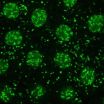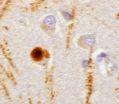(Press-News.org) Systemic lupus erythematosus (SLE) is a complicated multifactorial autoimmune disease influenced by many genetic and environmental factors. The hallmark of systemic lupus erythematosus (SLE) is the presence of high levels of anti-double-stranded DNA autoantibody (anti-dsDNA) in sera. In addition, greater infection rates are found in SLE patients and higher morbidity and mortality usually come from bacterial infections. Deciphering interactions between the susceptibility genes and the environmental factors for lupus complex traits is challenging and has resulted in only limited success.
In the June issue of Experimental Biology and Medicine Lee et al, from National Yang-Ming University in Taiwan, studied the role of anti-double stranded DNA (anti-dsDNA) and the Toll-like receptors (TLRs), TLR4 and TLR9, in the pathogenesis of lupus. They prepared transgenic mice carrying the anti-dsDNA transgene and challenged these mice with TLR4 and TLR9 agonists. They demonstrate that in the anti-dsDNA transgenic mice TLR4 and TLR9 are cooperatively linked to Lupus progression.
''Since simultaneous activation of extracellular and intracellular pattern-recognition receptors (PRR) is able to trigger more intense host immune responses, it is really crucial to determine whether co-engagement of extracellular and intracellular PRRs may increase disease severity in lupus,'' said Dr. Kuang-Hui Sun, corresponding author. However, only individual conditional knockout models were used in previous studies to study the roles of TLR4 or TLR9. In addition, intracellular nucleic acid-sensing TLR9 plays either stimulatory or protective roles in different murine lupus models. Therefore, Sun and colleagues injected the ligands of TLR4 and TLR9 into the anti-dsDNA transgenic mice as a new model to investigate whether anti-dsDNA and co-activation of extracellular TLR4 and endosomal TLR9 impacts the pathogenesis of lupus in normal background mice. Their data suggest that, in addition to anti-dsDNA, signaling pathways triggered by simultaneous activation of surface-expressed TLR4 and endosomal TLR9 can promote the progression of SLE. These results suggest that simultaneous targeting of anti-dsDNA, TLR4 and 9 may be a potential therapy for SLE.
Dr. Steven R. Goodman, Editor-in-Chief of Experimental Biology and Medicine, said "These studies in transgenic mice offer new concepts for affecting immune tolerance and reducing SLE disease progression as future therapeutics are developed."
INFORMATION:
Experimental Biology and Medicine is a journal dedicated to the publication of multidisciplinary and interdisciplinary research in the biomedical sciences. The journal was first established in 1903. Experimental Biology and Medicine is the journal of the Society of Experimental Biology and Medicine. To learn about the benefits of society membership visit http://www.sebm.org. If you are interested in publishing in the journal please visit http://ebm.sagepub.com/.
Anti-dsDNA, surface-expressed TLR4 and endosomal TLR9 cooperate to exacerbate lupus
2014-06-12
ELSE PRESS RELEASES FROM THIS DATE:
Protein anchors help keep embryonic development 'just right'
2014-06-12
The "Goldilocks effect" in fruit fly embryos may be more intricate than previously thought. It's been known that specific proteins, called histones, must exist within a certain range—if there are too few, a fruit fly's DNA is damaged; if there are too many, the cell dies. Now research out of the University of Rochester shows that different types of histone proteins also need to exist in specific proportions. The work further shows that cellular storage facilities keep over-produced histones in reserve until they are needed.
Associate Professor of Biology Michael Welte ...
Penn study describes new models for testing Parkinson's disease immune-based drugs
2014-06-12
PHILADELPHIA - Using powerful, newly developed cell culture and mouse models of sporadic Parkinson's disease (PD), a team of researchers from the Perelman School of Medicine at the University of Pennsylvania, has demonstrated that immunotherapy with specifically targeted antibodies may block the development and spread of PD pathology in the brain. By intercepting the distorted and misfolded alpha-synuclein (α-syn) proteins that enter and propagate in neurons, creating aggregates, the researchers prevented the development of pathology and also reversed some of the ...
Viral infections, including flu, could be inhibited by naturally occurring protein
2014-06-12
PITTSBURGH, June 12, 2014 – By boosting a protein that naturally exists in our cells, an international team of researchers led by the University of Pittsburgh Cancer Institute (UPCI), partner with UPMC CancerCenter, has found a potential way to enhance our ability to sense and inhibit viral infections.
The laboratory-based discovery, which could lead to more effective treatments for viruses ranging from hepatitis C to the flu, appears in the June 19 issue of the journal Immunity. The research is supported by the National Institutes of Health.
"Despite remarkable advances ...
African-Americans respond better to first-line diabetes drug than whites
2014-06-12
Washington, DC—African Americans taking the diabetes drug metformin saw greater improvements in their blood sugar control than white individuals who were prescribed the same medication, according to a new study published in the Endocrine Society's Journal of Clinical Endocrinology & Metabolism (JCEM).
An estimated 29 million Americans have diabetes. African Americans are twice as likely to be diagnosed with diabetes as whites and have a higher rate of complications such as kidney failure, according to the U.S. Department of Health and Human Services' Office of Minority ...
Brain power
2014-06-12
VIDEO:
Real-time movie of changes in total hemoglobin in the brain during stimulation. The initial blush of the brain is followed quickly by dilation (red) of arteries on the brain's surface....
Click here for more information.
New York, NY—June 12, 2014—In a new study published online in the Journal of the American Heart Association June 12, 2014, researchers at Columbia Engineering report that they have identified a new component of the biological mechanism that controls ...
Time-lapse study reveals bottlenecks in stem cell expansion
2014-06-12
A time-lapse study of human embryonic stems cells has identified bottlenecks restricting the formation of colonies, a discovery that could lead to improvement in their use in regenerative medicine.
Biologists at the University of Sheffield's Centre for Stem Cell Biology led by Professor Peter Andrews and engineers in the Complex Systems and Signal Processing Group led by Professor Daniel Coca studied human pluripotent stem cells, which are a potential source of cells for regenerative medicine because they have the ability to produce any cell type in the body.
However, ...
Synchronized brain waves enable rapid learning
2014-06-12
CAMBRIDGE, MA -- The human mind can rapidly absorb and analyze new information as it flits from thought to thought. These quickly changing brain states may be encoded by synchronization of brain waves across different brain regions, according to a new study from MIT neuroscientists.
The researchers found that as monkeys learn to categorize different patterns of dots, two brain areas involved in learning — the prefrontal cortex and the striatum — synchronize their brain waves to form new communication circuits.
"We're seeing direct evidence for the interactions between ...
Scientists find trigger to decode the genome
2014-06-12
Scientists from The University of Manchester have identified an important trigger that dictates how cells change their identity and gain specialised functions.
And the research, published today in Cell Reports, has brought them a step closer to being able to decode the genome.
The scientists have found out how embryonic stem cell fate is controlled which will lead to future research into how cells can be artificially manipulated.
Lead author Andrew Sharrocks, Professor in Molecular Biology at The University of Manchester, said: "Understanding how to manipulate cells ...
12 minutes of exercise improves attention, reading comprehension in low-income adolescents
2014-06-12
HANOVER, N.H. – June 12, 2014 – A new Dartmouth study Dartmouth study shows 12 minutes of exercise can improve attention and reading comprehension in low-income adolescents, suggesting that schools serving low-income populations should work brief bouts of exercise into their daily schedules.
The study, published as part of the June volume of Frontiers in Psychology, compared low-income adolescents with their high-income peers. While both groups saw improvement in selective visual attention up to 45 minutes after exercising, the low-income group experienced a bigger jump. ...
Opioid use prior to spine surgery linked to diminished patient reported outcomes
2014-06-12
ROSEMONT, Ill.─A new study appearing in the Journal of Bone and Joint Surgery (JBJS) links the use of opioid pain relievers (prescription medications, such as Percocet) to less improvement and higher levels of dissatisfaction following spine surgery.
Between 1999 and 2010, a greater focus on pain management resulted in a four-fold increase in opioids sold to hospitals, pharmacies and doctors' offices, and a related and ongoing increase in opioid-related complications, including opioid dependence, impaired cognition and poor treatment outcomes. Previous studies have ...


